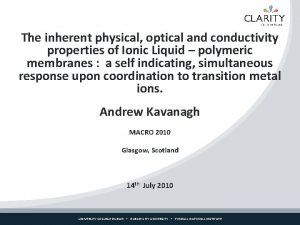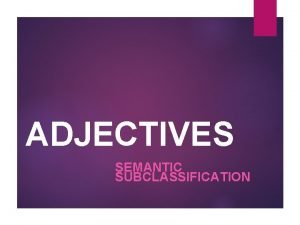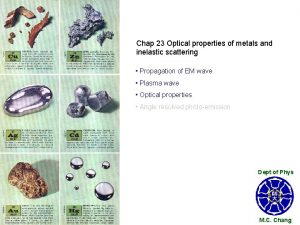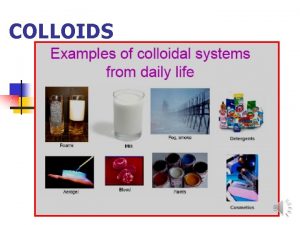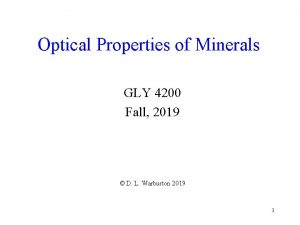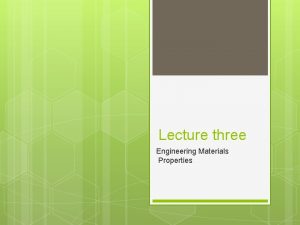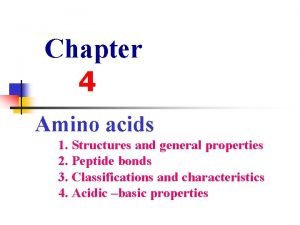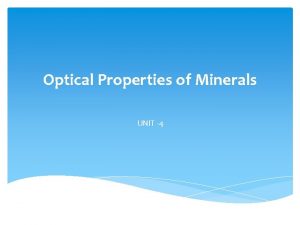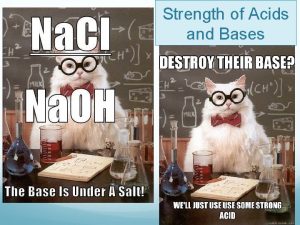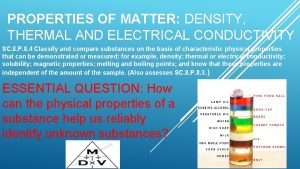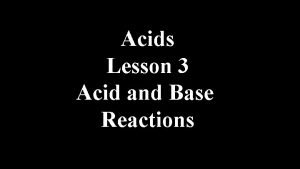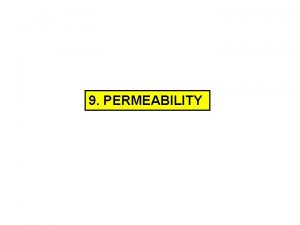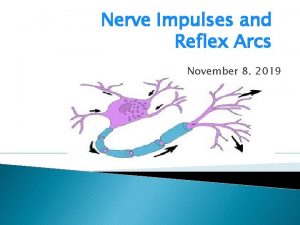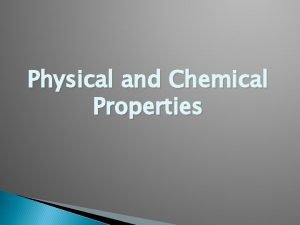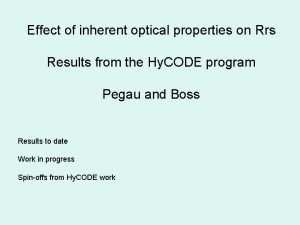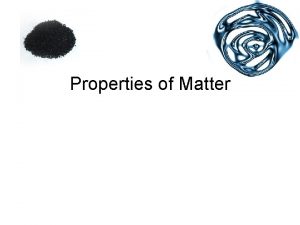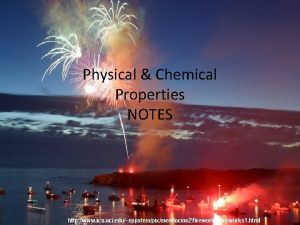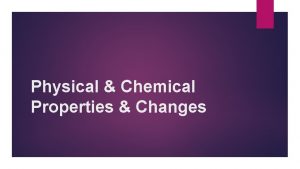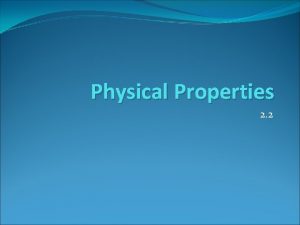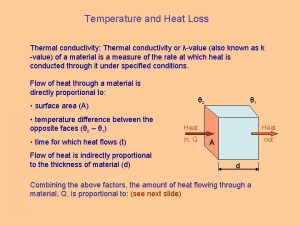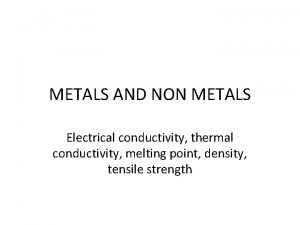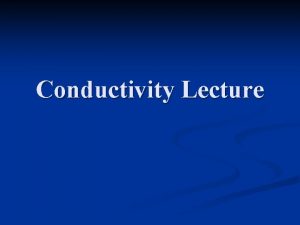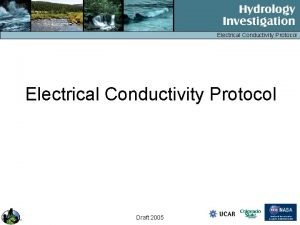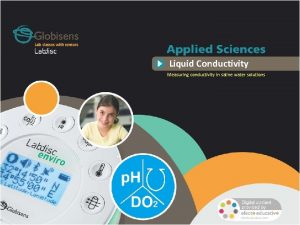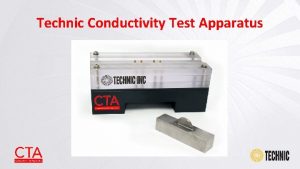The inherent physical optical and conductivity properties of






![Simple, 2 -component optodes Cu 2+ Co 2+ • [P 6, 6, 6, 14][DCA] Simple, 2 -component optodes Cu 2+ Co 2+ • [P 6, 6, 6, 14][DCA]](https://slidetodoc.com/presentation_image/8fc5e55e0e26ab98b5989e58b15648d6/image-7.jpg)











![XRF Results • Used to quantify [DCA]binding preferentiality • Co levels were found to XRF Results • Used to quantify [DCA]binding preferentiality • Co levels were found to](https://slidetodoc.com/presentation_image/8fc5e55e0e26ab98b5989e58b15648d6/image-19.jpg)
![Conclusions • The Ionic Liquid [P 6, 6, 6, 14][DCA] fulfils multiple roles in Conclusions • The Ionic Liquid [P 6, 6, 6, 14][DCA] fulfils multiple roles in](https://slidetodoc.com/presentation_image/8fc5e55e0e26ab98b5989e58b15648d6/image-20.jpg)


- Slides: 22

The inherent physical, optical and conductivity properties of Ionic Liquid – polymeric membranes : a self indicating, simultaneous response upon coordination to transition metal ions. Andrew Kavanagh MACRO 2010 Glasgow, Scotland 14 th July 2010 UNIVERSITY COLLEGE DUBLIN CITY UNIVERSITY TYNDALL NATIONAL INSTITUTE

Me. . • Graduated with B. Sc (Hons) in Chemical & Pharmaceutical Sciences, Dublin City University (2008). • Ph. D. in “Ionic Liquids and their use in the development of potential chemical sensors”. Sept 08’ • Supervisors Dr. Aleksandar Radu & Prof. Dermot Diamond UNIVERSITY COLLEGE DUBLIN CITY UNIVERSITY TYNDALL NATIONAL INSTITUTE

Outline • Ionic Liquids • Polymeric Optodes • Ionic Liquid – PVC Optodes Vibrational Spectroscopy UV/Vis Characterisation • Alternate Detection Techniques Wireless Radio Frequency Detection Electrochemical Impedance Spectroscopy Portable X-Ray Fluorescence UNIVERSITY COLLEGE DUBLIN CITY UNIVERSITY TYNDALL NATIONAL INSTITUTE

Ionic Liquids • Unique combination of ions that are liquid at room temperature • Choice of ion pair can have dramatic impact on Density Viscosity Miscibility with Solvents UNIVERSITY COLLEGE DUBLIN CITY UNIVERSITY TYNDALL NATIONAL INSTITUTE

Applications of IL’s • Synthesis & Catalysis in Organic Chemistry => Good thermal stability • Electrochemistry => Good Conductivity and a large electrochemical window • Analytical Chemistry => Stable stationary phase for separations UNIVERSITY COLLEGE DUBLIN CITY UNIVERSITY TYNDALL NATIONAL INSTITUTE

Polymeric Optodes • Typically contain up to 5 components • Polymer • Plasticizer Inert matrix to house active sensing components Lowers Tg of polymer to produce solid film • Ion-Exchanger Facilitates Ion Transfer from aq. to organic phase • Ionophore Selectively binds ion of interest • Transducer Dye Produces optical response PMMA optodes containing Spiropyran dye A. Radu, R. Byrne, N. Alhashimy and D. Diamond, Abstr. Pap. Am. Chem. Soc. , 2006, 231, 41 -INOR. UNIVERSITY COLLEGE DUBLIN CITY UNIVERSITY TYNDALL NATIONAL INSTITUTE
![Simple 2 component optodes Cu 2 Co 2 P 6 6 6 14DCA Simple, 2 -component optodes Cu 2+ Co 2+ • [P 6, 6, 6, 14][DCA]](https://slidetodoc.com/presentation_image/8fc5e55e0e26ab98b5989e58b15648d6/image-7.jpg)
Simple, 2 -component optodes Cu 2+ Co 2+ • [P 6, 6, 6, 14][DCA] acts as plasticizer ion-exchanger ligand transducer dye Cu 2+/Co 2+ Upon exposure to Cu 2+ and Co 2+ UNIVERSITY COLLEGE DUBLIN CITY UNIVERSITY TYNDALL NATIONAL INSTITUTE

Vibrational Spectroscopy IR ν max Cu-DCA : 2162 cm-1 Raman UNIVERSITY COLLEGE DUBLIN CITY UNIVERSITY TYNDALL NATIONAL INSTITUTE ν max Co-DCA : 2166 cm-1

Multianalyte Recognition UNIVERSITY COLLEGE DUBLIN CITY UNIVERSITY TYNDALL NATIONAL INSTITUTE

Stoichiometry Estimation • Best fit was found to be 2 M for 1 L UNIVERSITY COLLEGE DUBLIN CITY UNIVERSITY TYNDALL NATIONAL INSTITUTE

Dicyanamide • Used to impart low viscosity in a new generation of Ionic Liquids • Pseudohalide, shown in literature to bind to an array of TM elements • Due to strong electron delocalisation across molecule, resulting in a variety of binding modes • Rich binding diversity results in many 1, 2 and 3 -D co-ordinated networks reported M S. R. Batten, P. Jensen, B. Moubaraki, K. S. Murray and R. Robson, Chem. Commun. , 1998, 439 -440. S. R. Batten and K. S. Murray, Coordination Chemistry Reviews, 2003, 246, 103 -130. UNIVERSITY COLLEGE DUBLIN CITY UNIVERSITY TYNDALL NATIONAL INSTITUTE DCA

Interference Spectra • DCA- exhibits a higher binding preferentiality for Cu 2+ over Co 2+ • Ni 2+ has been shown to bind to DCA-, yet produces no optical response J. Kohout, L. Jager, M. Hvastijova and J. Kozisek, J. Coord. Chem. , 2000, 51, 169 -218. UNIVERSITY COLLEGE DUBLIN CITY UNIVERSITY TYNDALL NATIONAL INSTITUTE

RF Wireless Conductivity Detection • In conjunction with CSIRO Laboratories, Melbourne, Australia • Works by passing low voltage, low frequency AC signal from transmitting to receiving electrodes • Sample is housed in an insulating container • Conductive sample produces a signal as it passes through the electrode field UNIVERSITY COLLEGE DUBLIN CITY UNIVERSITY TYNDALL NATIONAL INSTITUTE

RF Wireless Conductivity Detection • Depending on p. H, polyaniline (PAni) can switch between conductive and non-conductive forms • Ink jet printed Pani dispersion sensitive to both Ammonia and Acetic Acid vapour N. B. Clark and L. J. Maher, Reactive & Functional Polymers, 2009, 69, 594 -600. UNIVERSITY COLLEGE DUBLIN CITY UNIVERSITY TYNDALL NATIONAL INSTITUTE

Wireless Recognition of Conductive Membranes • WRF has the required sensitivity to distinguish between complexed and non-complexed membranes • “Edge effects” occur as insulating material first enters and leaves electrode channel Membrane Group: Ionic Liquid Copper Mix Cobalt PVC: IL (1: 2) 52486. 14 39292. 66 40267. 75 43479. 93 PVC: IL (1: 1) 15879. 97 7068. 51 9428. 30 14908. 19 PVC: IL (2: 1) 7502. 65 0. 00 UNIVERSITY COLLEGE DUBLIN CITY UNIVERSITY TYNDALL NATIONAL INSTITUTE

Screen Printed Electrodes • PET substrate • Ag/Ag. Cl ink used as conducting path • Carbon Paste used as working electrode • Insulating Layer defines the working area • Conducting polymer (Poly (3 -octylthiophene)) is first dropcast to aid ionic to electronic transition • PVC-IL cocktail dropcast and allowed to dry A. Morrin, A. J. Killard and M. R. Smyth, Analytical Letters, 2003, 36, 2021 -2039. UNIVERSITY COLLEGE DUBLIN CITY UNIVERSITY TYNDALL NATIONAL INSTITUTE

Impedance Spectroscopy • PVC: IL 1: 2 (w/w) • PVC: IL (1: 1 w/w) UNIVERSITY COLLEGE DUBLIN CITY UNIVERSITY TYNDALL NATIONAL INSTITUTE

LOD Calcualtions Cu-DCA LOD: 7. 55 x 10 -3 M Cu-DCA LOD: Co-DCA LOD: UNIVERSITY COLLEGE DUBLIN CITY UNIVERSITY TYNDALL NATIONAL INSTITUTE 7. 62 x 10 -4 M 2. 91 x 10 -4 M
![XRF Results Used to quantify DCAbinding preferentiality Co levels were found to XRF Results • Used to quantify [DCA]binding preferentiality • Co levels were found to](https://slidetodoc.com/presentation_image/8fc5e55e0e26ab98b5989e58b15648d6/image-19.jpg)
XRF Results • Used to quantify [DCA]binding preferentiality • Co levels were found to be 45% lower • Even as a mixture (2: 1 Co: Cu (vol. )) Co levels are 88% lower! Membrane Copper: Cobalt: Composition: Mixture Copper: Cobalt: 2551. 91 (164. 43) 272. 17 (83. 39) 80. 98 (21. 56) 69. 59 ( 168. 57) 1559. 59 (179. 21) 192. 55 (81. 51) < LOD 202. 62 (88. 09) < LOD 1. PVC: IL (1: 1 w/w) 2642. 14 (165. 73) 1207. 55 (153. 38) 2. PVC: IL (1: 2 w/w) 16996. 25 (424. 75) 7652. 11 (371. 17) 12866. 82 (357. 98) 3. PVC: IL (2: 1 w/w) 222. 53 (77. 79) < LOD Blank 294. 12 (90. 91) UNIVERSITY COLLEGE DUBLIN CITY UNIVERSITY TYNDALL NATIONAL INSTITUTE
![Conclusions The Ionic Liquid P 6 6 6 14DCA fulfils multiple roles in Conclusions • The Ionic Liquid [P 6, 6, 6, 14][DCA] fulfils multiple roles in](https://slidetodoc.com/presentation_image/8fc5e55e0e26ab98b5989e58b15648d6/image-20.jpg)
Conclusions • The Ionic Liquid [P 6, 6, 6, 14][DCA] fulfils multiple roles in polymeric optodes • Conductive membranes allow for detection via an array of techniques • The relative ease of synthesis and diversity allows for the possibility of new IL’s with greater selectivity UNIVERSITY COLLEGE DUBLIN CITY UNIVERSITY TYNDALL NATIONAL INSTITUTE

Acknowledgements • Dr. Aleksandar Radu and Professor Dermot Diamond • Everyone at ASG • Dr’s. Noel Clarke and Matthius Hilder at CSIRO • Cytec Industries • DCU Research Career Start Fellowship 2008 • Science Foundation Ireland (grant 07/CE/I 1147) • Enterprise Ireland (grant 07/RFP/MASF 812) UNIVERSITY COLLEGE DUBLIN CITY UNIVERSITY TYNDALL NATIONAL INSTITUTE

• Thanks for listening! UNIVERSITY COLLEGE DUBLIN CITY UNIVERSITY TYNDALL NATIONAL INSTITUTE
 Inherent optical properties
Inherent optical properties Inherent and non inherent adjectives
Inherent and non inherent adjectives Physical and chemical properties
Physical and chemical properties Optical properties of metals and nonmetals
Optical properties of metals and nonmetals Tyndall effect is an optical property
Tyndall effect is an optical property Optical properties of minerals
Optical properties of minerals Optical properties of engineering materials
Optical properties of engineering materials Properties of amino acids
Properties of amino acids Symmetrical extinction of minerals
Symmetrical extinction of minerals Inherent thoughtfulness and emotionality
Inherent thoughtfulness and emotionality 4 powers of congress
4 powers of congress Darcy's law
Darcy's law Model 1 acid strength and conductivity
Model 1 acid strength and conductivity Electrical conductivity property of matter
Electrical conductivity property of matter Is co32- amphiprotic
Is co32- amphiprotic Difference between permeability and hydraulic conductivity
Difference between permeability and hydraulic conductivity Excitability and conductivity
Excitability and conductivity Irritability and conductivity
Irritability and conductivity Intensive and extensive properties
Intensive and extensive properties Inherent powers examples
Inherent powers examples Inherent drama
Inherent drama Full faith and credit
Full faith and credit Inherent powers
Inherent powers
